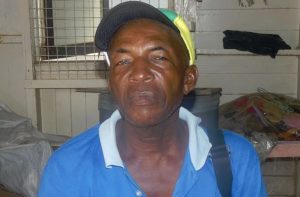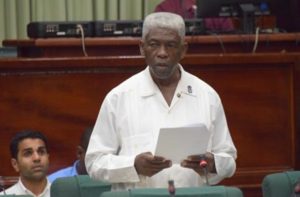– concrete roads, potable water, improved education system now available
FOR the first time in history, Port Kaituma, located in the Matarkai Sub-Region, Barima-Waini (Region One), has not just one but a number of concrete road networks linking the community to Mathew’s Ridge and other villages.

The development of roads in the community is a hallmark achievement for the Coalition Government, residents told Guyana Chronicle, explaining that it not only transformed the image of Port Kaituma, but has created a positive domino effect in the community’s economy, education and health sectors, among other key areas.
Prior to the construction of the road networks, for decades, Port Kaituma only had mud dams for roads which added to its dusty and gloomy appearance. These roads lacked drains and, during the rainy season, residents experienced tremendous flooding, which caused significant losses to businesses. The ‘roads’ were also riddled with craters and potholes and, as a result, transportation was a sore issue.
Tiffnie Daniels, a resident of Port Kaituma, told Guyana Chronicle that the construction of the road networks is a major plus for the community. “One of the most positive development is the road; it was taken over with mud, most of the times when the rain fall, the place muddy, when the sun shine the place dusty; but this road is really good because they have children coming from Four Mile and these places,” she said.
The region’s Member of Parliament, Richard Alleyne, said the development of the roads in Port Kaituma has had positive impacts on the business community. In the past, many businesses were forced to close their doors due to the challenge of transporting goods from the capital city – Georgetown – to Port Kaituma, and the excessive dust in the area, including Alleyne’s clothing store, but today, he said the ‘tide is turning.’
“Now, I can put up my clothes and it won’t full up with dust; when it rained, nobody came up there because it was filled with mud, but now I can open back my business,” the Parliamentarian said.
Similar sentiments were expressed by other business owners in the ‘Water-Front’ area, where clothes, groceries, food and haberdashery businesses line the new concrete road. They said, in the past, businesses were tremendously affected by the state of the road but their calls for betterment fell on deaf ears.
No more overnighting on the trail
In addition to the construction of the roads, residents said the rehabilitation of the road network that connects Port Kaituma to other communities such as Matthew’s Ridge, Baramita, Arakaka and Takatu has significantly reduced the travel time to those areas. As a result, drivers are saving thousands of dollars in fuel, spare parts and maintenance. “The road is very good with the state that it is in now; kudos to the government, because with the previous administration, a truck used to take a whole day but now the truck making two trips to Baramita; cars going to Baramita, cars going to Takatu and those places, that is development…,” Malcolm Peters, a resident, told this newspaper.

According to MP Alleyne, the local mining sector was severely affected due to the poor state of the roads in Port Kaituma and other villages within the sub-region. In 2016, the road networks underwent massive reconstruction and today, remain in good condition. “To date, that road is standing up; we don’t have a problem where persons were made to stay two and three days on the road travelling from here to Matthew’s Ridge. We had to travel in a convoy, so we can push out each other. If you go alone, that means you had to sit down at certain spots and wait,” Alleyne explained. Life and limb were at risk and the accident rate was high, he said. Today, the travel time to these communities is shorter, and fewer accidents are reported. “In the line of costing, it saved business persons millions of dollars. It will save persons travel time, now you can get in a vehicle here and you can get to Mathew’s Ridge in an hour and half, you can get to Baramita in three hours…previously it took 12 hours,” he said.
Potable water and electricity reaching residents
Residents also related that for the first time, potable water is now available in the taps of those living in remote areas. Electrification is also being extended to villages that were previously neglected, they said. “People that never saw water in their taps, they have potable water, electricity is being extended,” Peters said. “These are tangible evidence of the coalition’s efforts to transform lives. The president said that if someone is getting water on the coast, the same must be the case for those in the hinterland,” he added.
Students excelling, particularly at the Caribbean Secondary Education Certificate (CSEC) is also evidence of the government’s input into the education sector in the hinterland region. Region One continues to benefit from the Public Education Transportation System (PETS) and the Five B’s initiative. Schools are also now equipped with internet access.
All of the schools in the sub-region, except for the Port Kaituma Secondary School, are benefiting from the hot meal programme. “Education wise, I am very much amazed about it, because back then, you getting the education, but now you’re seeing the progress in the education system presently because a lot of students are now excelling,” Daniels said. She is, however, calling for the establishment of a library and an ICT hub in the community.

Acknowledging that Matarkai has been neglected for decades, she said, “this government has opened the previous government’s eye and they cannot stand that, because we were way behind.”
President David Granger, on Friday, told residents of Port Kaituma that it is just the tip of the iceberg and with the oil wealth, Region One will be on the top of his priority list. He referred to the district as the number one region. “People call it Region Number One, but I call it the Number One Region, it should be number one in mining, number one in agriculture, number one in eco-tourism.
So this is my message to you today, do not believe that you are bush, do not believe that you are in the back dam; believe that like every other Guyanese, you have a say in this great country,” he said.



.jpg)









